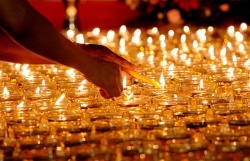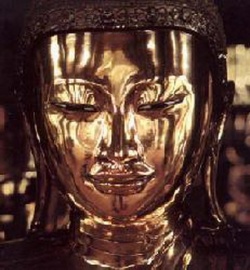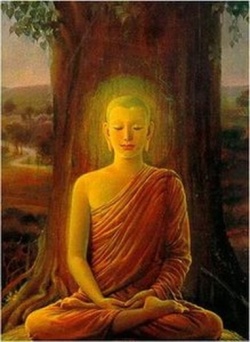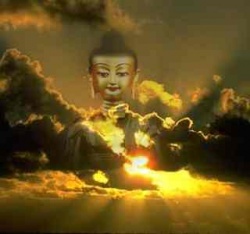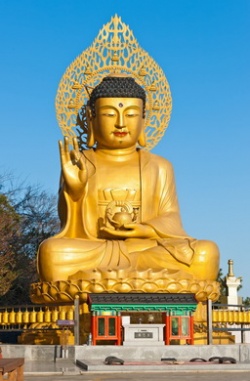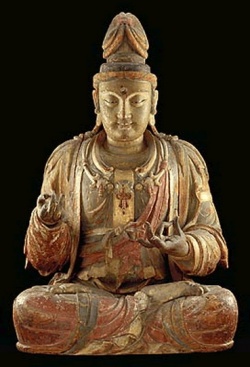Difference between revisions of "Nyingma Gyubum"
| Line 1: | Line 1: | ||
[[File:Candles 1.jpg|thumb|250px|]] | [[File:Candles 1.jpg|thumb|250px|]] | ||
<poem> | <poem> | ||
| + | 'Nyingma Gyubum' (Tibetan: རྙིང་མ་རྒྱུད་འབུམ, Wylie: rnying ma rgyud ‘bum) is the 'Collected Tantras of the Ancients', that is the Mahayoga, Anuyoga and Atiyoga Tantras of the Nyingma. | ||
| + | |||
| + | |||
| + | Canonization | ||
| + | |||
| + | The Nyingma Gyubum of the Nyingma was a dependent arising resulting from the 'normalization' of the Kangyur and Tengyur by the Sarma traditions which for the most part excluded Nyingma literatures. Davidson (2005: p. 225) opines that the first edition of the Nyingma Gyubum began formation by the twelfth century with certain texts drawn from the Terma literature. | ||
| + | Space Class | ||
| + | |||
| + | According to Thondup & Talbott (1997: p. 48) there are only seven extant texts of the Space Class and they are collected in the Nyingma Gyubum. | ||
| + | Extant versions | ||
| + | |||
| + | Cantwell and Mayer have since 1996 published four monographs on the rNying ma'i rGyud 'bum, and have critically edited a number of its texts. Their work has established that the nine easily available extant versions fall into three distinct lines of descent. Thus the four Bhutanese versions of Tshamdrag, Gangteng-A, Gangteng-B and Drametse form one line of descent, all from a Lhalung original. The Rigzin, Tingkye, Kathmandu and Nubri versions all hail from a common ancestor in South Central Tibet, but Kathmandu and Nubri are of a slightly different sub-branch to the Tingkye and Rigzin. Dege is unique unto itself. | ||
| + | [[File:OnzeBuddha.jpg|thumb|250px|]] | ||
| + | Harunaga & Almogi (July, 2009) hold that there are at minimum seven extant versions of the Nyingma Gyubum of different sizes, ranging from 26 to 46 volumes in length. | ||
| + | Degé (Wylie: sde dge) Edition | ||
| + | |||
| + | The terton Ratna Lingpa (1403–1471) was important in the compilation of the Nyingma Gyubum's first evocation and Jikme Lingpa (1729–1798) built upon this compilation and it was published with the impetus of Getse Mahapandita (1761–1829), one of Jigme Lingpa's disciples, through patronage of the royal house of Degé. | ||
| + | |||
| + | Further to this, Rigpa Shedra (2009) hold that the Nyingma Gyubum: | ||
| + | |||
| + | "...was first compiled by the great tertön Ratna Lingpa after similar compilations of texts made in the 14th century, such as the Kangyur and the Tengyur, had omitted many of the Nyingma tantras. It was first published towards the end of the 18th century under the guidance of the Omniscient Jikmé Lingpa, in Derge, thanks to the patronage of the regent queen Tsewang Lhamo." | ||
| + | |||
| + | Jigme Lingpa gathered Nyingma texts that had become rare, starting with Nyingma tantras held in the manuscript collection of the Mindrolling Monastery. This collection of the Nyingma tantras led to the amassing of the 'Collection of Nyingma Tantras', the Nyingma Gyübum (Wylie: rNying-ma rgyud-'bum) for which Getse Mahapandita wrote the catalogue, proofread and arranged for its printing by soliciting the expensive and labour intensive project of carving the wood blocks for the block printing. The wood block carving was forded through the patronage of the 'Degé' (Wylie: sDe-dge ) Royal Family of Kham who favoured and honoured Jigme Lingpa. Getse Mahapandita proof read the Nyingma Gyübum. | ||
| + | |||
| + | Catalogue of the Nyingma Gyubum, Degé Edition: Table of Contents by Major Genres and Volumes @ THL Tibetan Literary Encyclopedia | ||
| + | [[File:Next-to-.jpg|thumb|250px|]] | ||
| + | Collected Tantras of Vairochana (Wylie: bai ro’i rgyud ’bum) | ||
| + | |||
| + | The 'Collected Tantras of Vairochana' (Tibetan: བཻ་རོའི་རྒྱུད་འབུམ, Wylie: bai ro’i rgyud ’bum) is collection of ancient tantras and esoteric instructions compiled and translated by the eighth century Tibetan master Vairochana. | ||
| + | |||
| + | Catalogue of the Collected Tantras of Vairochana @ THL Tibetan Literary Encyclopedia | ||
| + | |||
| + | Tingkyé (Wylie: gting skyes) Edition | ||
| + | |||
| + | In late last century, Dil mgo mkhyen brtse rin po che (顶果钦哲仁波切) (1910–1991) discover more manuscripts in Bhutan, 46 boxes in Mtshams brag monastery (禅扎寺) and 36 boxes in Gting skyes monastery (定切寺). This version is more complete. The texts were published by The National Library of Bhutan (不丹皇家政府国家图书馆) in 1982. | ||
| + | |||
| + | An admirable pioneering catalogue of this collection, including all titles, chapters and colophons, was made by Kaneko in Japan. Some years later, this was usefully rendered into a digital version by THDL. | ||
| + | Tsamdrak (Wylie: mtshams brag) Edition | ||
| + | |||
| + | Catalog of The Collected Tantras of the Ancients, Tsamdrak Edition @ THL Tibetan Literary Encyclopedia | ||
| + | [[File:Sep rinpoche ttl.jpg|thumb|250px|]] | ||
| + | Anthony Hanson-Barber provided the first title and colophons catalog of this collection. His work was then expanded into a fuller catalog including chapter headings by the THDL team. | ||
| + | |||
| + | Importantly, the Kunjed Gyalpo is the first text in the Tsamdrak edition of the Nyingma Gyubum. | ||
| + | Catalog of the Master Edition | ||
| + | |||
| + | Though not a true extant edition, the THL Tibetan Literary Encyclopedia under the directive of Germano has distilled a Master Edition taking the abovementioned editions into account. | ||
| + | |||
| + | Catalog of the Master Edition of the Nyingma Gyubum @ THL Tibetan Literary Encyclopedia | ||
| + | |||
| + | Rig 'dzin Tshe dbang nor bu Edition | ||
| + | |||
| + | Cantwell, Mayer and Fischer (2002) in association with their partnerships document the Rig 'dzin Tshe dbang nor bu Edition of the Nyingma Gyubum. | ||
| + | |||
| + | The Catalogue of the Rig 'dzin Tshe dbang nor bu rNying ma'i rgyud 'bum | ||
| + | The Rig 'dzin Tshe dbang nor bu Edition of the rNying ma'i rgyud 'bum: An Illustrated Inventory | ||
| + | |||
| + | 'Gangteng' (Wylie: sgang steng) Edition | ||
| + | |||
| + | Cantwell, Mayer, Kowalewski & Achard (2006) have published a catalogue in English of this edition of the Nyingma Gyubum. | ||
| + | Indigenous Himalayan discourse rendered in English: an emic narrative | ||
| + | What constitutes a tantra according to the Nyingma? | ||
| + | |||
| + | Early in the naturalization and acclimatization of Indian and Chinese tantric Buddhadharma and siddha traditions into the Himalaya and Greater Tibet in general, the Guhyagarbha Tantra (Wylie: gsang ba snying po) of the Mahayoga class of literature "represents the most normative vision of what constitutes a tantra for these Nyingma lineages". Indigenous Tibetan exegetical works discuss what constitutes a 'tantra' in an enumeration of ten or eleven "practical principles of tantra" (Wylie: rgyud kyi dngos po) understood as defining the distinctive features of mainstream tantric systems as understood and envisioned at that point in time: | ||
| + | [[File:Witha.jpg|thumb|250px|]] | ||
| + | 'A view of the real' (Wylie: de kho na nyid lta ba) | ||
| + | 'determinate conduct' (Wylie: la dor ba spyod pa) | ||
| + | 'mandala array' (Wylie: bkod pa dkyil 'khor) | ||
| + | 'successive gradation of empowerment' (Wylie: rim par bgrod pa dbang) | ||
| + | 'commitment which is not transgressed' (Wylie: mi 'da' ba dam tshig) | ||
| + | 'enlightened activity which is displayed' (Wylie: rol pa phrin las) | ||
| + | 'fulfillment of aspiration' (Wylie: don du gnyer ba sgrub pa) | ||
| + | 'offerings which brings the goal to fruition' (Wylie: gnas su stobs pa mchod pa) | ||
| + | 'unwavering contemplation' (Wylie: mi g.yo ba ting nge 'dzin), and | ||
| + | 'mantra recitation' (Wylie: zlos pa sngags) accompanied by 'the seal which binds the practitioner to realization' (Wylie: 'ching ba phyag rgya). | ||
| + | |||
| + | Modern 'Western' discourse in English: an etic narrative | ||
| + | Timeline of salient scholarship | ||
| + | [[File:435.jpg|thumb|250px|]] | ||
| + | Germano (1992) discussed the Atiyoga tantras in his thesis. Ehrhard (1995) documents the discovery of manuscripts of the Nyingma Gyubum from Nepal. In 1996 at the University of Leiden, Mayer completed the first PhD that was specifically on the rNying ma'i rGyud 'bum and its different editions. In his thesis he established for the first time the various branches of transmission of the rNying ma'i rGyud 'bum by stemmatic analysis. These three branches he identified as the East Tibetan, the Bhutanese, and the South Central Tibetan (which subdivides into two sub-branches). This remains the standard method to categorise the various rNying ma'i rGyud 'bum editions, since all editions subsequently discovered have been found to fall within one or another of these lines of transmission. Mayer's PhD also identified the first irrefutable proof of the sources of Mahāyoga texts, and reviewed what was then known of the rNying ma'i rGyud 'bum's history. Germano's earlier work was further appended with Germano (2000) specifically related to the Nyingma Gyubum. ] Cantwell, Mayer and Fischer (2002) in association with the British Library documented the Rig 'dzin Tshe dbang nor bu Edition of the Nyingma Gyubum. Cantwell and Mayer subsequently published their third monograph on the rNying ma'i rGyud 'bum, discussing its history and its various editions and providing critical editions of two sample texts: "The Kīlaya Nirvāṇa Tantra and the Vajra Wrath Tantra: Two Texts from the Ancient Tantra Collection". Vienna, 2006. Derbac (2007) tendered an MA thesis on the Nyingma Gyubum as a whole. In 2008, Mayer and Cantwell published their fourth monograph relating to the rNying ma'i rGyud 'bum, in which they showed that virtually all Dunhuang text on Phur pa subsequently reappeared within various parts of the rNying ma'i rGyud 'bum, thus proving that the rNying ma tantric materials are definitely contemporaneous with or older than the Dunhuang texts. As of 2010, they are still at Oxford University and completing their fifth volume on the rNying ma'i rGyud 'bum. As well as the monographs, they have also produced catalogues and many journal articles and conference papers on the rNying ma'i rGyud 'bum. | ||
| + | |||
| + | Etic discourse and narrative | ||
| + | |||
| + | In his MA thesis for the University of Alberta, in the terrain of scholarly etic discourse of the manifold Nyingma Gyubum editions, Derbac (2007: p. 2) proffers: | ||
| + | |||
| + | "...that the major editors of the various rNying ma'i rgyud 'bum editions played a far greater role in emending colophons, catalogues, and editions than scholars have previously assumed." | ||
| + | [[File:B va.JPG|thumb|250px|]] | ||
| + | In saying this, Derbac is agreeing on the one hand with emic traditional] scholarship, which frankly celebrates the major role of the famous editors such as Ratna Lingpa and Jigme Lingpa in compiling catalogues for the rNying ma'i rgyud 'bum. In addition, he is also confirming the conclusions of earlier scholarship, such as Mayer's Leiden PhD thesis of 1996, which was later published as a book 'The Phur pa bcu gnyis: A Scripture from the Ancient Tantra Collection' the conclusions of David Germano's THDL collection in the early 2000s, and Cantwell and Mayer's book 'The Kīlaya Nirvāṇa Tantra and the Vajra Wrath Tantra: Two texts from the Ancient Tantra Collection', published in 2006 by the Österreichische Akademie der Wissenschaften, Vienna. Derbac cites all the above three sources, as well as others of the works by Mayer and Cantwell on the rNying ma'i rGyud 'bum. | ||
| + | |||
| + | |||
'''Nyingma Gyubum''' (''rnying ma rgyud ‘bum''). | '''Nyingma Gyubum''' (''rnying ma rgyud ‘bum''). | ||
| Line 12: | Line 102: | ||
Rig 'dzin Tshe dbang nor bu Edition, manuscript with illumination, late 18th century, 33 vol. Only 30 vol. available. See http://ngb.csac.anthropology.ac.uk/Title_page_main.html | Rig 'dzin Tshe dbang nor bu Edition, manuscript with illumination, late 18th century, 33 vol. Only 30 vol. available. See http://ngb.csac.anthropology.ac.uk/Title_page_main.html | ||
gTing skyes Edition and Dilgo Khyentse Rinpoche Edition (1974, New Delhi;1975, Thimpu). The later was reproduced from the manuscripts preserved at Tingkye monastery in Tibet under the direction of Dilgo Khyentsé Rinpoche. 36 vol. | gTing skyes Edition and Dilgo Khyentse Rinpoche Edition (1974, New Delhi;1975, Thimpu). The later was reproduced from the manuscripts preserved at Tingkye monastery in Tibet under the direction of Dilgo Khyentsé Rinpoche. 36 vol. | ||
| − | mTshams brag Edition, National Library of Bhutan (1982, Thimpu) | + | mTshams brag Edition, National Library of Bhutan (1982, Thimpu) The manuscript from which this collection was printed was found at the monastery of Tsamdrag in western Bhutan and comprises 46 volumes. It was probably calligraphed in the 18th century. It is the largest version of the Nyingma Gyübum. For a catalog see http://jefferson.village.virginia.edu:6060/ntrp/tibet/tb.ed |
Further Reading | Further Reading | ||
Revision as of 12:41, 13 June 2013
'Nyingma Gyubum' (Tibetan: རྙིང་མ་རྒྱུད་འབུམ, Wylie: rnying ma rgyud ‘bum) is the 'Collected Tantras of the Ancients', that is the Mahayoga, Anuyoga and Atiyoga Tantras of the Nyingma.
Canonization
The Nyingma Gyubum of the Nyingma was a dependent arising resulting from the 'normalization' of the Kangyur and Tengyur by the Sarma traditions which for the most part excluded Nyingma literatures. Davidson (2005: p. 225) opines that the first edition of the Nyingma Gyubum began formation by the twelfth century with certain texts drawn from the Terma literature.
Space Class
According to Thondup & Talbott (1997: p. 48) there are only seven extant texts of the Space Class and they are collected in the Nyingma Gyubum.
Extant versions
Cantwell and Mayer have since 1996 published four monographs on the rNying ma'i rGyud 'bum, and have critically edited a number of its texts. Their work has established that the nine easily available extant versions fall into three distinct lines of descent. Thus the four Bhutanese versions of Tshamdrag, Gangteng-A, Gangteng-B and Drametse form one line of descent, all from a Lhalung original. The Rigzin, Tingkye, Kathmandu and Nubri versions all hail from a common ancestor in South Central Tibet, but Kathmandu and Nubri are of a slightly different sub-branch to the Tingkye and Rigzin. Dege is unique unto itself.
Harunaga & Almogi (July, 2009) hold that there are at minimum seven extant versions of the Nyingma Gyubum of different sizes, ranging from 26 to 46 volumes in length.
Degé (Wylie: sde dge) Edition
The terton Ratna Lingpa (1403–1471) was important in the compilation of the Nyingma Gyubum's first evocation and Jikme Lingpa (1729–1798) built upon this compilation and it was published with the impetus of Getse Mahapandita (1761–1829), one of Jigme Lingpa's disciples, through patronage of the royal house of Degé.
Further to this, Rigpa Shedra (2009) hold that the Nyingma Gyubum:
"...was first compiled by the great tertön Ratna Lingpa after similar compilations of texts made in the 14th century, such as the Kangyur and the Tengyur, had omitted many of the Nyingma tantras. It was first published towards the end of the 18th century under the guidance of the Omniscient Jikmé Lingpa, in Derge, thanks to the patronage of the regent queen Tsewang Lhamo."
Jigme Lingpa gathered Nyingma texts that had become rare, starting with Nyingma tantras held in the manuscript collection of the Mindrolling Monastery. This collection of the Nyingma tantras led to the amassing of the 'Collection of Nyingma Tantras', the Nyingma Gyübum (Wylie: rNying-ma rgyud-'bum) for which Getse Mahapandita wrote the catalogue, proofread and arranged for its printing by soliciting the expensive and labour intensive project of carving the wood blocks for the block printing. The wood block carving was forded through the patronage of the 'Degé' (Wylie: sDe-dge ) Royal Family of Kham who favoured and honoured Jigme Lingpa. Getse Mahapandita proof read the Nyingma Gyübum.
Catalogue of the Nyingma Gyubum, Degé Edition: Table of Contents by Major Genres and Volumes @ THL Tibetan Literary Encyclopedia
Collected Tantras of Vairochana (Wylie: bai ro’i rgyud ’bum)
The 'Collected Tantras of Vairochana' (Tibetan: བཻ་རོའི་རྒྱུད་འབུམ, Wylie: bai ro’i rgyud ’bum) is collection of ancient tantras and esoteric instructions compiled and translated by the eighth century Tibetan master Vairochana.
Catalogue of the Collected Tantras of Vairochana @ THL Tibetan Literary Encyclopedia
Tingkyé (Wylie: gting skyes) Edition
In late last century, Dil mgo mkhyen brtse rin po che (顶果钦哲仁波切) (1910–1991) discover more manuscripts in Bhutan, 46 boxes in Mtshams brag monastery (禅扎寺) and 36 boxes in Gting skyes monastery (定切寺). This version is more complete. The texts were published by The National Library of Bhutan (不丹皇家政府国家图书馆) in 1982.
An admirable pioneering catalogue of this collection, including all titles, chapters and colophons, was made by Kaneko in Japan. Some years later, this was usefully rendered into a digital version by THDL.
Tsamdrak (Wylie: mtshams brag) Edition
Catalog of The Collected Tantras of the Ancients, Tsamdrak Edition @ THL Tibetan Literary Encyclopedia
Anthony Hanson-Barber provided the first title and colophons catalog of this collection. His work was then expanded into a fuller catalog including chapter headings by the THDL team.
Importantly, the Kunjed Gyalpo is the first text in the Tsamdrak edition of the Nyingma Gyubum.
Catalog of the Master Edition
Though not a true extant edition, the THL Tibetan Literary Encyclopedia under the directive of Germano has distilled a Master Edition taking the abovementioned editions into account.
Catalog of the Master Edition of the Nyingma Gyubum @ THL Tibetan Literary Encyclopedia
Rig 'dzin Tshe dbang nor bu Edition
Cantwell, Mayer and Fischer (2002) in association with their partnerships document the Rig 'dzin Tshe dbang nor bu Edition of the Nyingma Gyubum.
The Catalogue of the Rig 'dzin Tshe dbang nor bu rNying ma'i rgyud 'bum
The Rig 'dzin Tshe dbang nor bu Edition of the rNying ma'i rgyud 'bum: An Illustrated Inventory
'Gangteng' (Wylie: sgang steng) Edition
Cantwell, Mayer, Kowalewski & Achard (2006) have published a catalogue in English of this edition of the Nyingma Gyubum.
Indigenous Himalayan discourse rendered in English: an emic narrative
What constitutes a tantra according to the Nyingma?
Early in the naturalization and acclimatization of Indian and Chinese tantric Buddhadharma and siddha traditions into the Himalaya and Greater Tibet in general, the Guhyagarbha Tantra (Wylie: gsang ba snying po) of the Mahayoga class of literature "represents the most normative vision of what constitutes a tantra for these Nyingma lineages". Indigenous Tibetan exegetical works discuss what constitutes a 'tantra' in an enumeration of ten or eleven "practical principles of tantra" (Wylie: rgyud kyi dngos po) understood as defining the distinctive features of mainstream tantric systems as understood and envisioned at that point in time:
'A view of the real' (Wylie: de kho na nyid lta ba)
'determinate conduct' (Wylie: la dor ba spyod pa)
'mandala array' (Wylie: bkod pa dkyil 'khor)
'successive gradation of empowerment' (Wylie: rim par bgrod pa dbang)
'commitment which is not transgressed' (Wylie: mi 'da' ba dam tshig)
'enlightened activity which is displayed' (Wylie: rol pa phrin las)
'fulfillment of aspiration' (Wylie: don du gnyer ba sgrub pa)
'offerings which brings the goal to fruition' (Wylie: gnas su stobs pa mchod pa)
'unwavering contemplation' (Wylie: mi g.yo ba ting nge 'dzin), and
'mantra recitation' (Wylie: zlos pa sngags) accompanied by 'the seal which binds the practitioner to realization' (Wylie: 'ching ba phyag rgya).
Modern 'Western' discourse in English: an etic narrative
Timeline of salient scholarship
Germano (1992) discussed the Atiyoga tantras in his thesis. Ehrhard (1995) documents the discovery of manuscripts of the Nyingma Gyubum from Nepal. In 1996 at the University of Leiden, Mayer completed the first PhD that was specifically on the rNying ma'i rGyud 'bum and its different editions. In his thesis he established for the first time the various branches of transmission of the rNying ma'i rGyud 'bum by stemmatic analysis. These three branches he identified as the East Tibetan, the Bhutanese, and the South Central Tibetan (which subdivides into two sub-branches). This remains the standard method to categorise the various rNying ma'i rGyud 'bum editions, since all editions subsequently discovered have been found to fall within one or another of these lines of transmission. Mayer's PhD also identified the first irrefutable proof of the sources of Mahāyoga texts, and reviewed what was then known of the rNying ma'i rGyud 'bum's history. Germano's earlier work was further appended with Germano (2000) specifically related to the Nyingma Gyubum. ] Cantwell, Mayer and Fischer (2002) in association with the British Library documented the Rig 'dzin Tshe dbang nor bu Edition of the Nyingma Gyubum. Cantwell and Mayer subsequently published their third monograph on the rNying ma'i rGyud 'bum, discussing its history and its various editions and providing critical editions of two sample texts: "The Kīlaya Nirvāṇa Tantra and the Vajra Wrath Tantra: Two Texts from the Ancient Tantra Collection". Vienna, 2006. Derbac (2007) tendered an MA thesis on the Nyingma Gyubum as a whole. In 2008, Mayer and Cantwell published their fourth monograph relating to the rNying ma'i rGyud 'bum, in which they showed that virtually all Dunhuang text on Phur pa subsequently reappeared within various parts of the rNying ma'i rGyud 'bum, thus proving that the rNying ma tantric materials are definitely contemporaneous with or older than the Dunhuang texts. As of 2010, they are still at Oxford University and completing their fifth volume on the rNying ma'i rGyud 'bum. As well as the monographs, they have also produced catalogues and many journal articles and conference papers on the rNying ma'i rGyud 'bum.
Etic discourse and narrative
In his MA thesis for the University of Alberta, in the terrain of scholarly etic discourse of the manifold Nyingma Gyubum editions, Derbac (2007: p. 2) proffers:
"...that the major editors of the various rNying ma'i rgyud 'bum editions played a far greater role in emending colophons, catalogues, and editions than scholars have previously assumed."
In saying this, Derbac is agreeing on the one hand with emic traditional] scholarship, which frankly celebrates the major role of the famous editors such as Ratna Lingpa and Jigme Lingpa in compiling catalogues for the rNying ma'i rgyud 'bum. In addition, he is also confirming the conclusions of earlier scholarship, such as Mayer's Leiden PhD thesis of 1996, which was later published as a book 'The Phur pa bcu gnyis: A Scripture from the Ancient Tantra Collection' the conclusions of David Germano's THDL collection in the early 2000s, and Cantwell and Mayer's book 'The Kīlaya Nirvāṇa Tantra and the Vajra Wrath Tantra: Two texts from the Ancient Tantra Collection', published in 2006 by the Österreichische Akademie der Wissenschaften, Vienna. Derbac cites all the above three sources, as well as others of the works by Mayer and Cantwell on the rNying ma'i rGyud 'bum.
Nyingma Gyubum (rnying ma rgyud ‘bum).
The Nyingma Gyübum (Wyl. rnying ma rgyud ’bum) is a collection of Nyingma tantras. It was first compiled by the great tertön Ratna Lingpa after similar compilations of texts made in the 14th century, such as the Kangyur and the Tengyur, had omitted many of the Nyingma tantras. It was first published towards the end of the 18th century under the guidance of the Omniscient Jikmé Lingpa, in Dergé, thanks to the patronage of the regent queen of Dergé Tsewang Lhamo.
Today the collection exists in various editions, which differ slightly in their content and in the way they are organized, although they share a core set of texts, and are all organized according to the three categories of Mahayoga, Anuyoga and Atiyoga. The collection includes both termas and kama texts.
Editions of the Nyingma Gyübum
Bai ro'i rgyud 'bum compiled and translated by the eighth century Tibetan master Vairotsana. Reproduced from the rare manuscript belonging to Tokden Rinpoche of Gangon by Tashi Y. Tashigangpa. The 8 volume Bairo Gyubum is a collection of Nyingmapa tantra material found among the nomads of northern Ladakh. The lineage of transmission of these teachings has disappeared.
sDe dge Edition First published under the direction of Jikme Lingpa and the patronage of the queen of Derge at the end of the 18th century. 26 vol.
Rig 'dzin Tshe dbang nor bu Edition, manuscript with illumination, late 18th century, 33 vol. Only 30 vol. available. See http://ngb.csac.anthropology.ac.uk/Title_page_main.html
gTing skyes Edition and Dilgo Khyentse Rinpoche Edition (1974, New Delhi;1975, Thimpu). The later was reproduced from the manuscripts preserved at Tingkye monastery in Tibet under the direction of Dilgo Khyentsé Rinpoche. 36 vol.
mTshams brag Edition, National Library of Bhutan (1982, Thimpu) The manuscript from which this collection was printed was found at the monastery of Tsamdrag in western Bhutan and comprises 46 volumes. It was probably calligraphed in the 18th century. It is the largest version of the Nyingma Gyübum. For a catalog see http://jefferson.village.virginia.edu:6060/ntrp/tibet/tb.ed
Further Reading
Cathy Cantwell and Rob Mayer, "The sGang steng-b rNying ma'i rGyud 'bum manuscript from Bhutan", Revue d’Etudes Tibétaines No. 11, June 2006
Cathy Cantwell, “Distinctive features of the Rig ‘dzin tshe dbang nor bu (Waddell) Edition of the rNying ma’i rgyud ‘bum”, in Helmut Eimer & David Germano, The Many Canons of Tibetan Buddhism, Brill’s Tibetan Studies Library, vol. 2, p. 359-376.
Franz-Karl Ehrhard, 'Recently discovered manuscripts of the rNying ma rgyud 'bum from Nepal'. In H. Krasser, M. Torsten Much, E. Steinkellner, H. Tauscher, Tibetan Studies: Proceedings of the 7th Seminar of the International Association for Tibetan Studies, Graz 1995, Volume I: 253-267.
Mihai Derbac, rNying ma'i rgyud ’bum: A Tibetan Buddhist Canon, University of Alberta, 2007
Tulku Thondup, Hidden Teachings of Tibet (Boston: Wisdom, reprint edition 1997), 'Appendix 3: Categories of Texts in The Collection of the Ancient Tantras'.
Achard, Jean-Luc “La liste des Tantras du rNying ma’i rgyud ‘bum selon l’édition établie par Kun mkhyen ‘Jigs med gling pa”, Revue d’Etudes Tibétaines, no. 1, Paris, CNRS, 2002, p. 62-89.
Achard, Jean-Luc, "Rig ‘dzin Tshe dbang mchog grub (1761-1829) et la constitution du rNying ma’i rgyud ‘bum de sDe dge”, Revue d'études tibétaines, n° 3 : 43-89.
‘The Hundred Thousand Tantras of the Old School.’ A collection of scriptures belonging to the Three Inner Tantras, gathered by Ratna Lingpa and re-edited by Jigmey Lingpa. Various editions exist, but the numbering of the volumes used in this book are from the version in 36 volumes published by His Holiness Dilgo Khyentse Rinpoche, New Delhi, 1974. Structure of this edition: 10 volumes of Ati Yoga, 3 volumes of Anu Yoga, 6 volumes of the Tantra Section of Mahayoga, 13 volumes of the Sadhana Section of Mahayoga, 1 volume of protector tantras, and 3 volumes of catalogues and historical background.
